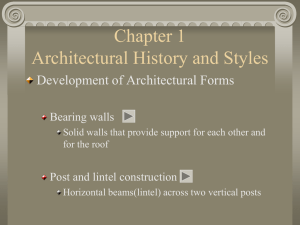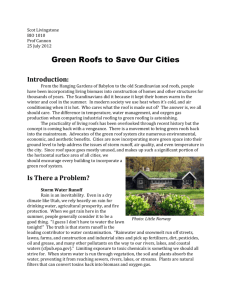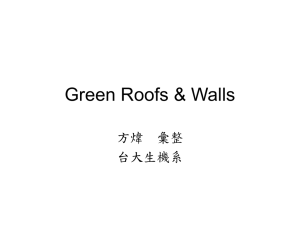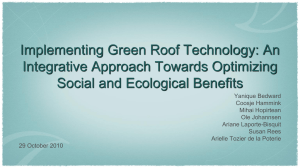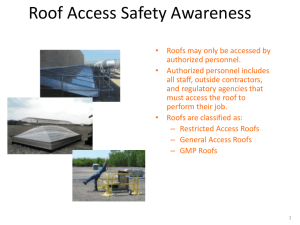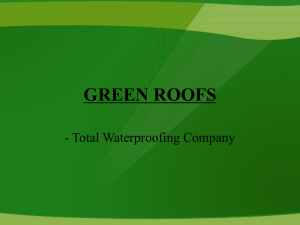This paper outlines the advantages of utilizing green roofs in heavy
advertisement
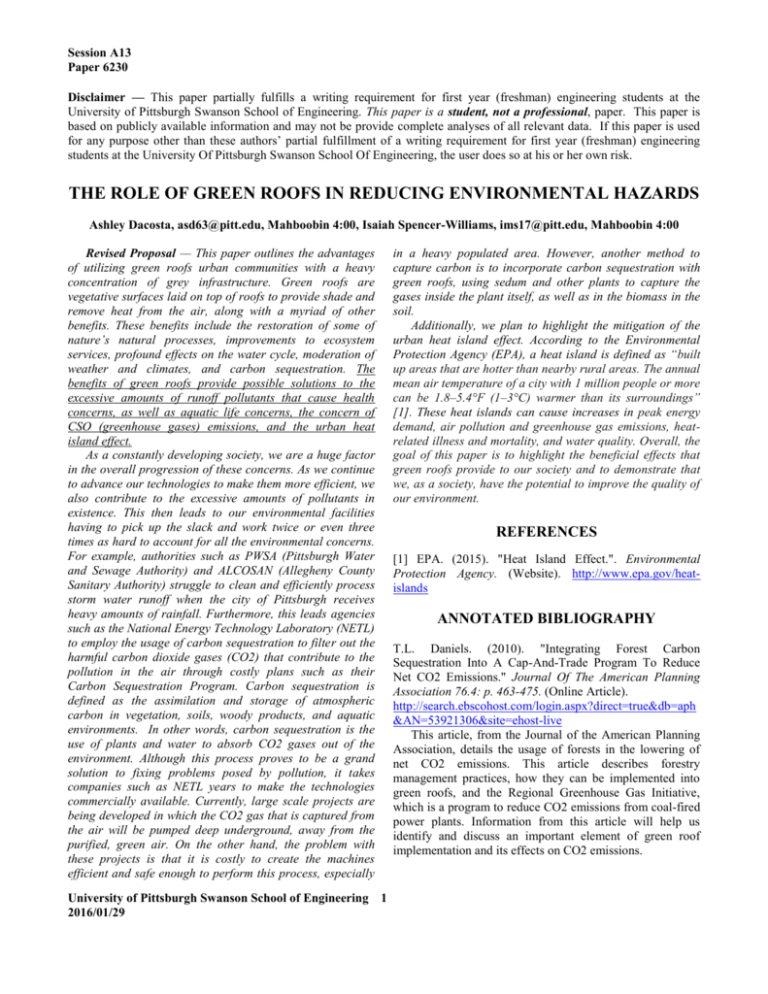
Session A13 Paper 6230 Disclaimer — This paper partially fulfills a writing requirement for first year (freshman) engineering students at the University of Pittsburgh Swanson School of Engineering. This paper is a student, not a professional, paper. This paper is based on publicly available information and may not be provide complete analyses of all relevant data. If this paper is used for any purpose other than these authors’ partial fulfillment of a writing requirement for first year (freshman) engineering students at the University Of Pittsburgh Swanson School Of Engineering, the user does so at his or her own risk. THE ROLE OF GREEN ROOFS IN REDUCING ENVIRONMENTAL HAZARDS Ashley Dacosta, asd63@pitt.edu, Mahboobin 4:00, Isaiah Spencer-Williams, ims17@pitt.edu, Mahboobin 4:00 Revised Proposal — This paper outlines the advantages of utilizing green roofs urban communities with a heavy concentration of grey infrastructure. Green roofs are vegetative surfaces laid on top of roofs to provide shade and remove heat from the air, along with a myriad of other benefits. These benefits include the restoration of some of nature’s natural processes, improvements to ecosystem services, profound effects on the water cycle, moderation of weather and climates, and carbon sequestration. The benefits of green roofs provide possible solutions to the excessive amounts of runoff pollutants that cause health concerns, as well as aquatic life concerns, the concern of CSO (greenhouse gases) emissions, and the urban heat island effect. As a constantly developing society, we are a huge factor in the overall progression of these concerns. As we continue to advance our technologies to make them more efficient, we also contribute to the excessive amounts of pollutants in existence. This then leads to our environmental facilities having to pick up the slack and work twice or even three times as hard to account for all the environmental concerns. For example, authorities such as PWSA (Pittsburgh Water and Sewage Authority) and ALCOSAN (Allegheny County Sanitary Authority) struggle to clean and efficiently process storm water runoff when the city of Pittsburgh receives heavy amounts of rainfall. Furthermore, this leads agencies such as the National Energy Technology Laboratory (NETL) to employ the usage of carbon sequestration to filter out the harmful carbon dioxide gases (CO2) that contribute to the pollution in the air through costly plans such as their Carbon Sequestration Program. Carbon sequestration is defined as the assimilation and storage of atmospheric carbon in vegetation, soils, woody products, and aquatic environments. In other words, carbon sequestration is the use of plants and water to absorb CO2 gases out of the environment. Although this process proves to be a grand solution to fixing problems posed by pollution, it takes companies such as NETL years to make the technologies commercially available. Currently, large scale projects are being developed in which the CO2 gas that is captured from the air will be pumped deep underground, away from the purified, green air. On the other hand, the problem with these projects is that it is costly to create the machines efficient and safe enough to perform this process, especially University of Pittsburgh Swanson School of Engineering 1 2016/01/29 in a heavy populated area. However, another method to capture carbon is to incorporate carbon sequestration with green roofs, using sedum and other plants to capture the gases inside the plant itself, as well as in the biomass in the soil. Additionally, we plan to highlight the mitigation of the urban heat island effect. According to the Environmental Protection Agency (EPA), a heat island is defined as “built up areas that are hotter than nearby rural areas. The annual mean air temperature of a city with 1 million people or more can be 1.8–5.4°F (1–3°C) warmer than its surroundings” [1]. These heat islands can cause increases in peak energy demand, air pollution and greenhouse gas emissions, heatrelated illness and mortality, and water quality. Overall, the goal of this paper is to highlight the beneficial effects that green roofs provide to our society and to demonstrate that we, as a society, have the potential to improve the quality of our environment. REFERENCES [1] EPA. (2015). "Heat Island Effect.". Environmental Protection Agency. (Website). http://www.epa.gov/heatislands ANNOTATED BIBLIOGRAPHY T.L. Daniels. (2010). "Integrating Forest Carbon Sequestration Into A Cap-And-Trade Program To Reduce Net CO2 Emissions." Journal Of The American Planning Association 76.4: p. 463-475. (Online Article). http://search.ebscohost.com/login.aspx?direct=true&db=aph &AN=53921306&site=ehost-live This article, from the Journal of the American Planning Association, details the usage of forests in the lowering of net CO2 emissions. This article describes forestry management practices, how they can be implemented into green roofs, and the Regional Greenhouse Gas Initiative, which is a program to reduce CO2 emissions from coal-fired power plants. Information from this article will help us identify and discuss an important element of green roof implementation and its effects on CO2 emissions. Ashley Dacosta Isaiah Spencer-Williams J.C. DeNardo, A.R. Jarrett, H.B. Manbeck, D.J. Beattie, R.D. Berghage (2005). “Stormwater mitigation and surface temperature reduction by green roofs.” Trans ASAE, 48 (4). (Online Article). http://web.a.ebscohost.com/ehost/command/detail?sid=9388 ae0c-0296-4760-be5965857da17792%40sessionmgr4002&vid=29&hid=4212 This article from the American Society of Agricultural and Biological Engineers outlines and discusses an evaluation of a certain type of green roof and analyzes the mitigation effects provided by green roofs. This article also analyzes the surface temperature reduction aspects of the green roof based on the different types of layers that can be used when constructing it. Information from this article will aid us in discussing what actually goes into the making of a green roof and how those components affect mitigation and stormwater runoff capture rates. this article will help us in defining a green roof and what purpose it serves, while giving us limiting information on cost variability. General Service Administration (2011). “The Benefits and Challenges of Green Roofs on Public and Commercial Buildings.” A Report of the United States General Services Administration. (Online PDF) http://www.gsa.gov/portal/mediaId/158783/fileName/Th e_Benefits_and_Challenges_of_Green_Roofs_on_Public_an d_Commercial_Buildings.action This report from the United States General Services Administration goes into detail about the use of green roofs in urban and suburban environments. This report also outlines the benefits and drawbacks of two different types of green roofs in use. Information from this report will aid us in speaking about the beneficial aspects of green roofs, while providing us with real figures and statistical information about green roof usage. R. Dolesh (2012). “Parks Are Green Infrastructure.” Parks & Recreation. (Online Article). http://web.a.ebscohost.com/ehost/detail/detail?vid=82&sid= 9388ae0c-0296-4760-be5965857da17792%40sessionmgr4002&hid=4212&bdata=JnN pdGU9ZWhvc3QtbGl2ZQ%3d%3d#AN=76147552&db=ap h This article from Richard Dolesh of the National Recreation & Park Association looks at the significance and value of parks and public green spaces as components of sustainable development in the U.S. It regards resiliency, which measures the natural systems function over various conditions and challenges, as the key concept in understanding the green infrastructure's importance and value. Information from this article will help us in defining what resiliency is and how it plays a key role in the development of the green roof. Getter, K. L. (2009). “Extensive green roofs: Carbon sequestration potential and species evaluations” (Online Article). http://search.proquest.com/docview/304931533?accounti d=14709 This dissertation written by Kristin Getter outlines and details a study of the intrinsic carbon storage properties of green roofs. This also outlines the importance of plant choice and substrate depth when implementing a green roof in terms of the carbon removal properties. Information from this dissertation will aid us in explaining the different effects that different plants have on the energy saving and mitigation properties of green roofs. K. Merry, et al. (2015). "Estimating Urban Forest Carbon Sequestration Potential In The Southern United States Using Current Remote Sensing Imagery Sources." Geographia Technica 10.2 : 78-89. (Online Article). http://search.ebscohost.com/login.aspx?direct=true&db=aph &AN=110646927&site=ehost-live This article from the University of Georgia and the United States Department of Agriculture (USDA) outlines the potential for Urban forestry, or the use of green roofs, and other green infrastructures based on carbon dioxide levels in certain areas. With the use of remote sensing imagery, the USDA and the University of Georgia were able to determine the availability of plantable areas using land cover classes from the program Landsat 8. Information from this will allow us to make sound determinations on whether the use of a green roof is appropriate in certain areas and will aid us in discussing location as a limiting factor for the implementation of green roofs. EPA . (2015) "Heat Island Effect.". Environmental Protection Agency. (Website). http://www.epa.gov/heat-islands This article from the Environmental Protection Agency defines the term “heat island.” The article describes the effects it has on the environment and society. Information from this article will aid us in defining the urban heat island effect, as well as to describe the effects green roofs have on it. EPA. (2015). "Using Green Roofs to Reduce Heat Islands." Environmental Protection Agency. (Online Article). http://www.epa.gov/heat-islands/using-green-roofs-reduceheat-islands This article from the Environmental Protection Agency defines the term “green roof,” and outlines some statistical data from its usage in the United States. This also describes the beneficial effects of the green roof and gives some insight into the cost of implementation. Information from National Energy Technology Laboratory. (2011). “Enhancing the success of Carbon Capture and Storage Technologies”. Technology Program Plan. (Online PDF). 2 Ashley Dacosta Isaiah Spencer-Williams https://www.netl.doe.gov/File%20Library/Research/Carbon %20Seq/Reference%20Shelf/2011_Sequestration_Program_ Plan.pdf This PDF from the National Energy Technology Laboratory discusses a plan started in 1997 to remove the excessive levels of carbon emissions from the air. This PDF also provides statistical analyses of the plan and the affect that it will have on the environment. Information from this PDF will aid us in the discussion of why plans such as this are not sufficient enough in comparison to the implementation of green roofs. Yanling, L., & Babcock, J. W. (2014). “Green roof hydrologic performance and modeling: a review.” Water Science & Technology, 69(4), 727-738 .(Online article) http://web.b.ebscohost.com/ehost/command/detail?sid=e036 99b3-bf9f-40fa-ab0e387249236a7a%40sessionmgr120&vid=26&hid=124 This article from the academic journal, Water Science & Technology, reviews technical literature on green roof hydrology. It discusses the effectiveness of the green roof and its substantial variability due to design characteristics that make performance predictions difficult. It also covers the major factors affecting green roof hydrology as precipitation volume, precipitation dynamics, antecedent conditions, growth medium, plant species, and roof slope. Information from this article will allow us to accurately discuss and analyze real data on the performance of green roofs. 3

